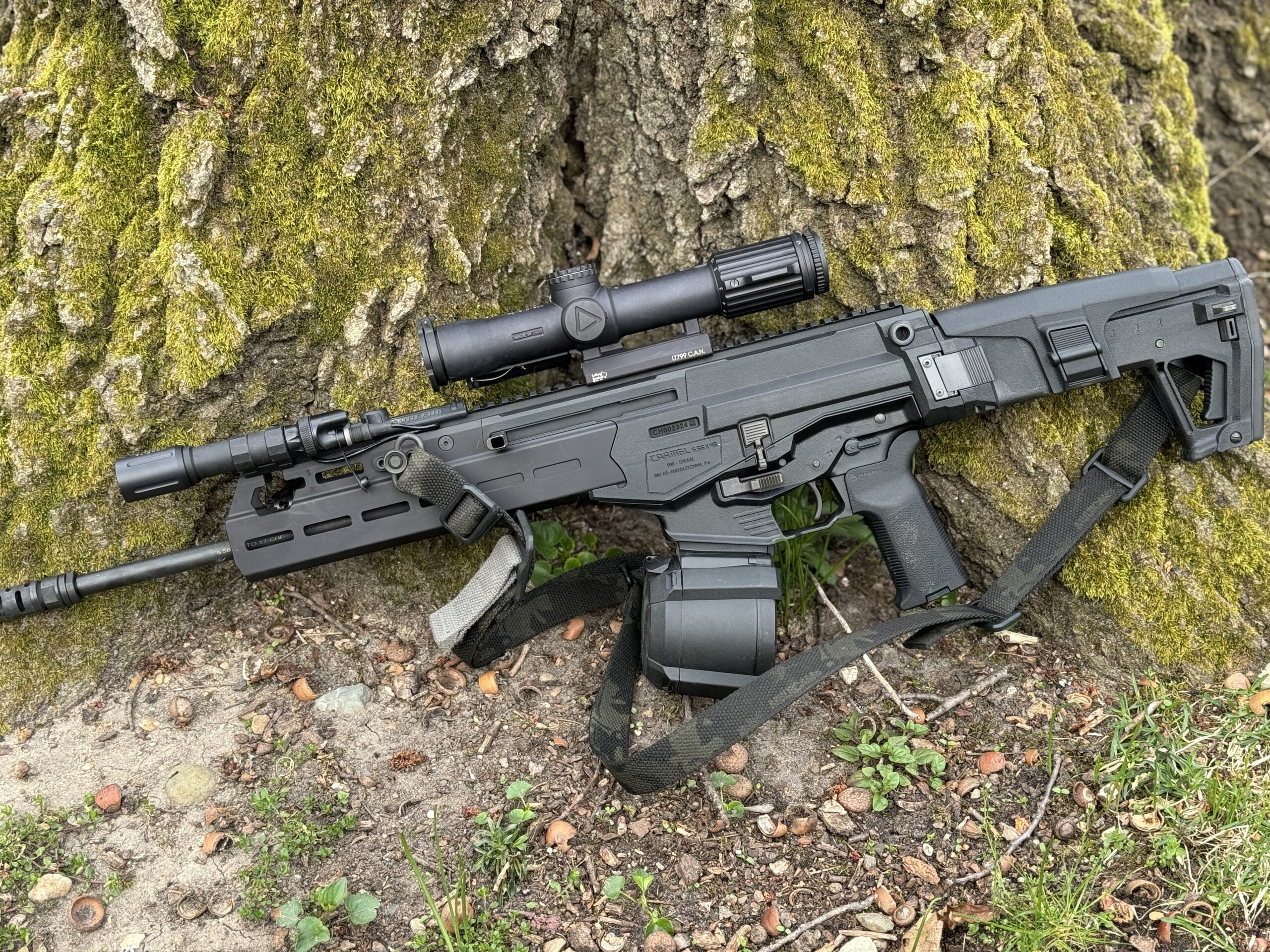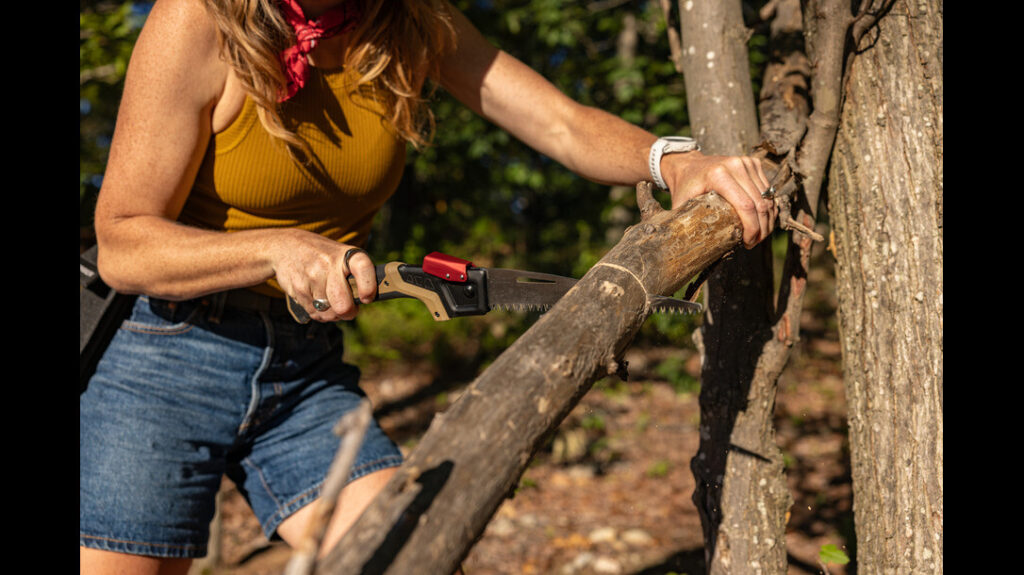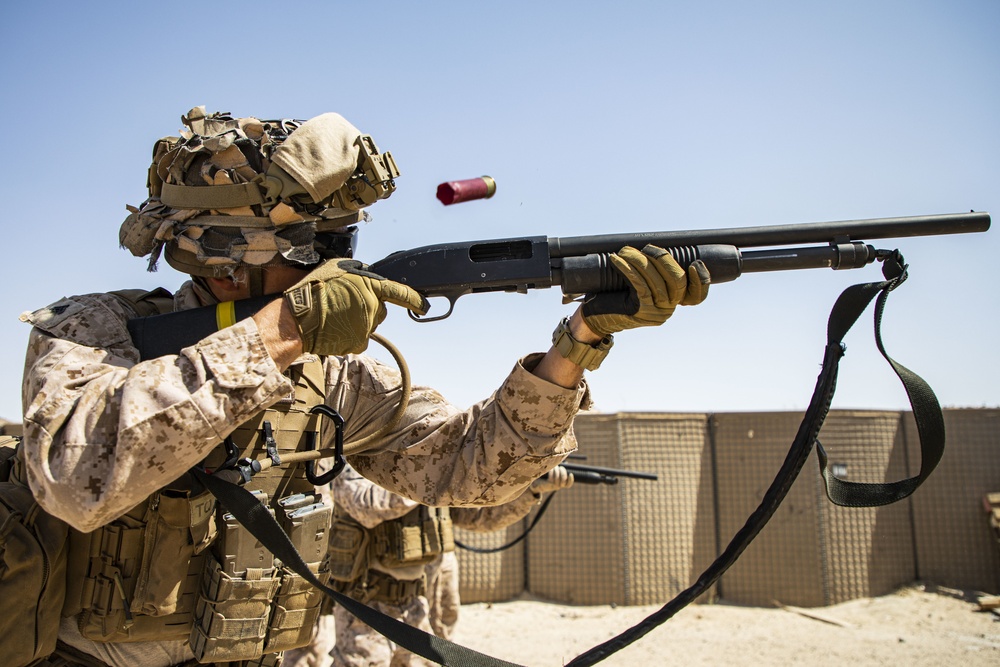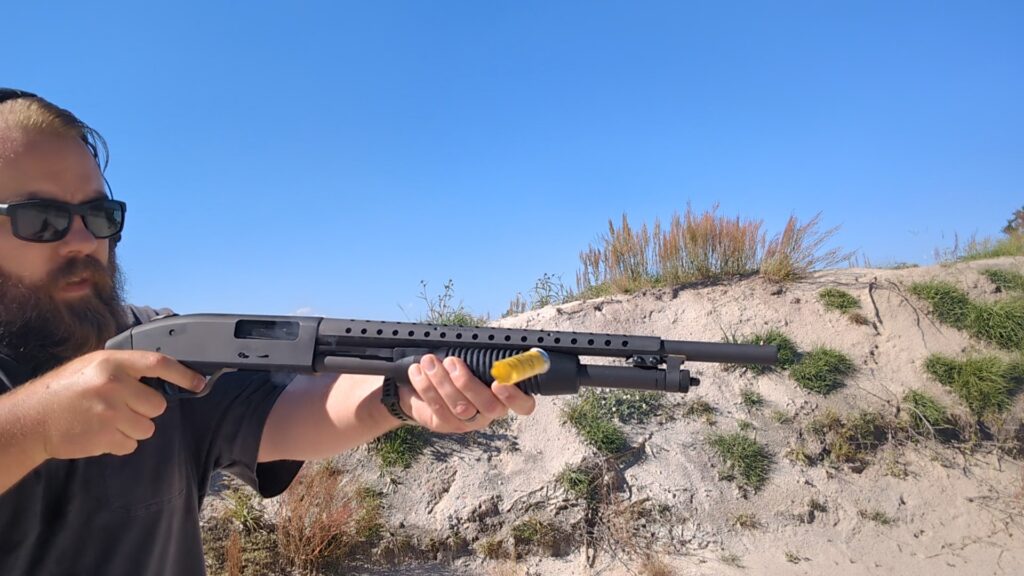If I had to sum up the US Marine’s Squad Common Optic (SCO) in a single phrase, the modern idiom ‘Absolute Unit’ would probably suffice. The VCOG 1-6x and 1-8x optic lines, designed and produced by Trijicon, are some of the most robust rifle optics on the market. Built to mirror the legendary durability of the ACOG while offering the superior optical versatility of an LPVO, the VCOG cemented a continued legacy for Trijicon when the Marine Corps picked the 1-8x MRAD variant to start replacing their aging RCO ACOGs, equipping the ground combat forces first and foremost.
“Heavy is good. Heavy is reliable.”
This quote from Guy Ritchie’s ‘Snatch’ accurately sums up both the H&K M27 and the VCOGs that now top them. They aren’t light weapon systems. While they are also a far cry from something like a Browning BAR (just shy of 20lbs), or a M249 Para SAW (just under 16lbs), there is a whole list of lighter rifles than the M27 HK416 variant and the VCOG+PEQ15 optic suite.
Coming in at about 13.5 lbs loaded, it isn’t light, but it isn’t absurdly heavy, either. It weighs what it needs to weigh to do what it needs to do with the components as designed. There are plenty of ways to shave weight in future PIPs on the system, too.
Advertisement — Continue Reading Below
The VCOG in isolation is the same way, and you avoid getting any measurement gimmicks where a company is gleefully bragging about the optic’s weight without any mount. For a good comparison, a Vortex Razor III in an AUS mount from Reptilia (a very viable military-grade optic setup) comes in only 5 oz lighter. Those 5 oz are well used in the VCOG.
Forged
One of the greatest ‘weaknesses’ of the variable optics selection is the number of parts involved in making them. Each moving part and mechanism adds a location where things can go wrong, like on the exterior, where water and debris could enter the scope. Those same points of interaction also represent the spots where parts are most likely to fail or take damage. They are the most sensitive to impacts and ingress.
Trijicon forges the body and base of the VCOG SCO from 7075-T6 and machines out the precise interactive surfaces from there. This is combined with their assembly methods and attention to detail to produce a variable optic with the ACOGs level of durability. That is a tall order, some might say a Herculean task.
Advertisement — Continue Reading Below
The additional complexity necessary in variable optics to support the difference in illumination and the erector usually means that variable optics are more delicate by necessity. The more complex the device, the more difficult maintaining the durability becomes.
As the illustrative example, standards for immersion and water resistance are lower on the military variable optics than on their ACOG, Aimpoint, and EOTech optical peers. This is because those three optics are simpler to build, have fewer moving parts, and can be better proofed and armored against the environment, thanks to that simplicity.
Trijicon looked at the impossible and said, “Eh, let’s try it anyway.”
Try it, the company did. Succeeded, too—at least more so than its peers. Most military variable optics are rated for surface-level water emersion. For example, they can get wet, rain won’t harm them as long as the caps are all on snug, getting dunked in the water crossing a river won’t fry them if the caps are snug, etc. However, the VOCG can go 20 meters down—66ft.
Advertisement — Continue Reading Below
Now, to be fair, the ACOG can go 100 meters (328ft). But given that most other ‘military grade’ variable optics are rated for 1 meter of immersion for 30 minutes (IPX7), with a few IPX8 ratings for specific greater depths and times, the VCOG stands alone for the moment.
Nothing about the VCOG is fragile. It maintains the overbuilt, nigh indestructibility, of its ACOG predecessor in an era when users were largely ready to conclude that we had to give that up.
My time with VCOGs
When Trijicon originally produced the VCOG line, I was intrigued. I hadn’t yet jumped down the LPVO rabbit hole the way I have now, where they are my go-to optic. But my use of the ACOG made me naturally inclined to like it.
Advertisement — Continue Reading Below
I was…underwhelmed…by my first use of them. The 1-6 “Donut of Death” reticles that mimicked the TA11s we’d been using on the M249s were…off. The reticle design didn’t translate well to a front focal plane variable scope, and it suffered from the illumination limitations common to that focal plane, at least at the time. It was (and is) expensive, with its main trick being durability far beyond what I needed in an optic.
As such, I did myself a disservice and didn’t look at the MOA or MRAD reticles. That was my mistake. Where the horseshoe BDC “Donut” reticle was not well suited to FFP variable applications—being very thick to be useful at 1x, it obscures the target quite a bit—the MIL and MOA reticles handle the challenge of scaling superbly.
MRAD Reticle
The MRAD reticle design was much friendlier when it came to the considerations of target obstruction and useability with the illumination on or off. The USMC also got wise to training their shooters smarter, even though it is a little harder, and using the milliradians in place of a Bullet Drop Compensator (BDC).
Advertisement — Continue Reading Below
The MRAD reticle in the VCOG SCO can go on any rifle, any caliber, and all the shooter needs to do is relearn/verify the holds. Print them out and stick them in their scope cover or shoot them on the range and live verify.
My suggestion is to learn them, shoot them live—even if you use an app to guess the initial ones—and verify the raw data. Even in military applications where ammunition is pretty well controlled, live data is best.

Advertisement — Continue Reading Below
Live Data – Play in the Mud
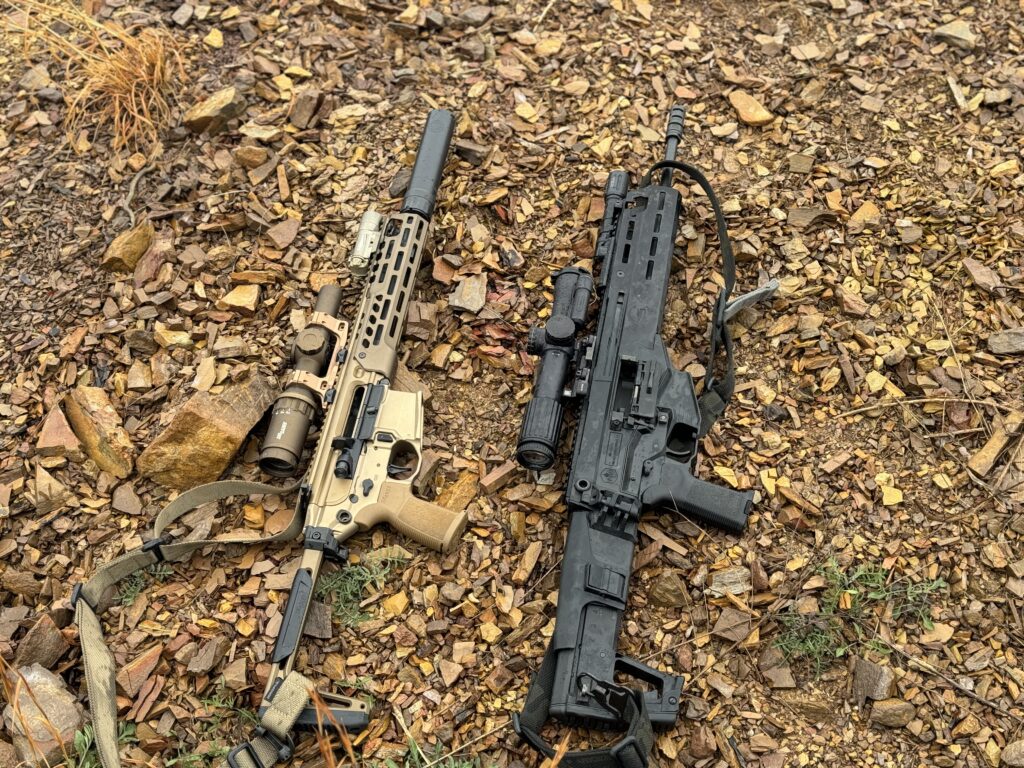
I don’t do field exercises anymore, but I do teach and attend classes and shoot the odd competition here and there. Green Ops LPVO, reviewed nicely here by Paul in West Virginia, sounded splendid.
…at the end of March…
Advertisement — Continue Reading Below
…with a bunch of wind, freezing rain, and mud…
Did I mention I don’t do field exercises anymore? I thought I did, but the spicy nostalgia is acting up for some reason…
Seriously though, courses and competitions are good places to verify gear. Pick one suited to the gear you are testing, and go shoot a few hundred rounds. I headed to the range with two carbines and two military optics, the SIG S-VPS and Trijcon SCO.
Advertisement — Continue Reading Below
Taking on an LPVO Course
LPVO courses aren’t about the carbines. They are about optics. LPVO optics are more complex, as has been stated, and unlike a dot or a fixed prism with a BDC, they require about as much learning time as the rifle they are on. It is a near equally complex part of the rifle system to learn and manage. Taking the proper time to do that leaves you with a rifle/optic combination that can likely shoot further, quicker, and with a far greater hit probability than you are used to.
LPVOs are about information. They inform the user with a better sight picture and the increased ability to select their holds more accurately and observe their influence on the target. At the same time, we must avoid thinking of them as “precision” rifle scopes. Their role is still that of the red dot and the prism, to get a fast and effective sight picture and begin making hits in as short a window as possible.
The VCOG SCO handled this hybrid of purposes superbly.
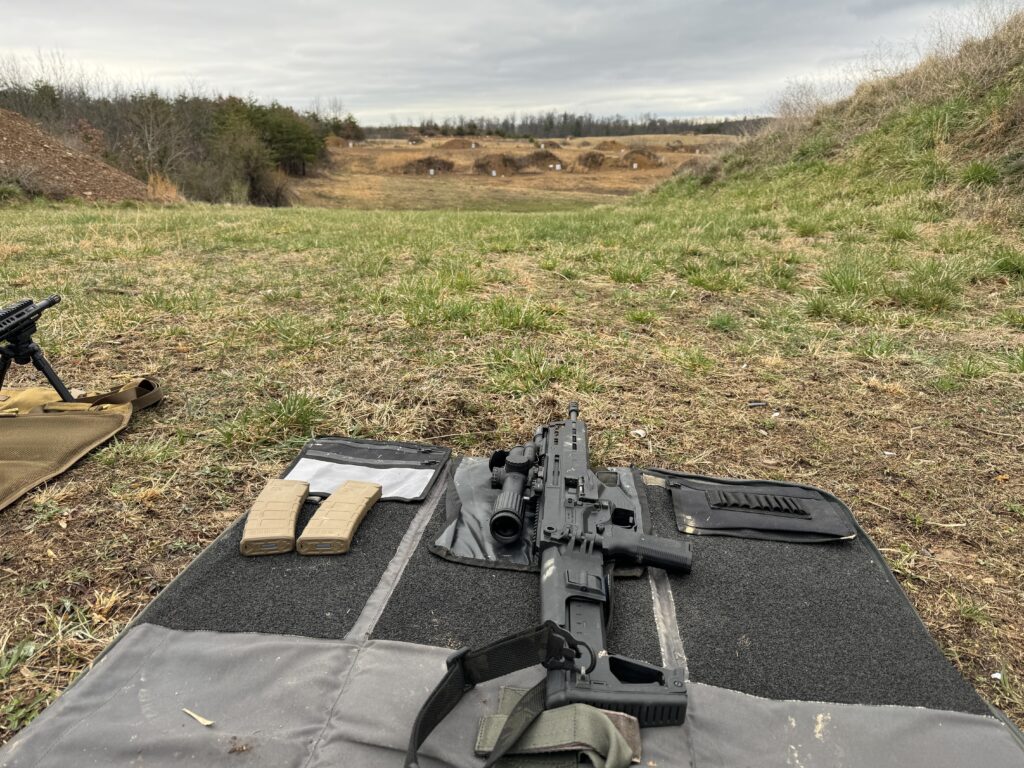
Additional Understandings
Let me take a detour to talk about controls for a minute. A user must understand the control scheme of their rifle in order to run it efficiently, which extends to the LPVO. Adjustments, Illumination, Magnification, and Reticle are your core points on the LPVO, just as Charging Controls, Magazine Controls, Safety Manipulation, and Trigger Manipulation are on the carbine.
Control the machine, get it to do what you need it to, and read the information it is telling you—optic and rifle. The complexity is again in that the optic now does a lot more, it isn’t essentially fixed like red dots or prisms are.
At the Green Ops class, we started this data gathering and understanding prone and at known distances. The target array in the picture above goes from 120 to 470 yards and with a variety of shapes and sizes. Odd target shape is a good approximation of an obscured target by cover or terrain. We used magnification, holds for distance and wind, and found out what our ammunition, rifles, and trigger fingers could do. Even the little 11.5″ MCX with the S-VPS hit 470 with 55gr without trying too hard.
These optics do magnify capability (see what I did there?), but the shooter needs to understand the complexity of the more complicated pair.
Live and Off-Hand
Once you have data, you get out of the prone.
We hit a different range, ran around, and shot off-hand at targets from 115 to 400 yards. The goal was to reinforce that these optics are ‘fighting’ scopes. They enhance what the rifle could do with a red dot or prism. They don’t turn it into a precision rifle. Get on the rifle and send the shot, correct if you miss and send it again.
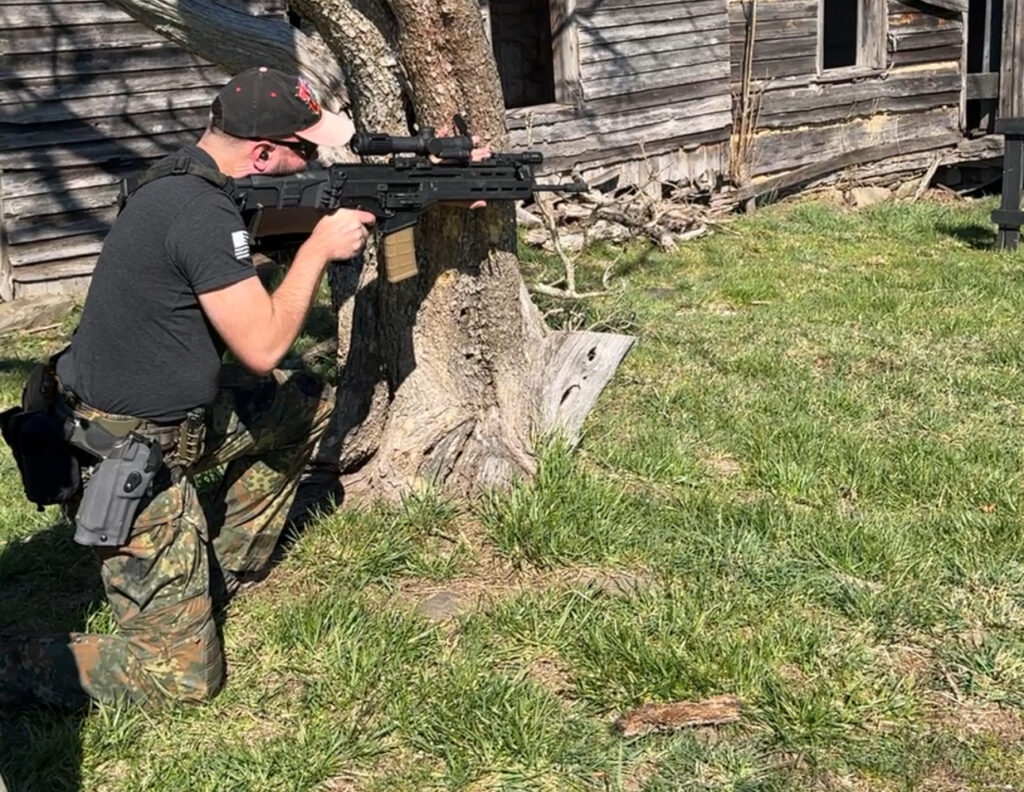
VCOG SCO – Recommended, not ‘Needed’
Do you need a Trijicon VCOG? No.
Do I recommend it? Yes. After shooting with it, I am keeping it, and it is only the second LPVO I am likely to purchase more than one of if I need an optic. The first is the Razor III.
The VCOG SCO is meant to be a mobile optic, and it accomplishes this purpose to great effect. Yes, even though it is heavy. The large control surface of the magnification dial allows for needed magnification changes without the probability of moving it inadvertently.
The reticle doesn’t interfere with the sight picture, with the segmented ring aligning close quick shots and the MRAD crosshair giving precise, quick holds. The glass provides the crisp, rich sight picture needed to find and fire on the target.
The Larue mount and power source AA keep the VCOG SCO a field manageable item. There is no requirement for an armorer’s bench, levels, or a torque wrench. It is an entirely by hand manageable optic. This toolless/tool-limited design philosophy pushes the VCOG SCO to the forefront of my recommendations for when you have field-specific requirements.
The Razor III remains my favorite LPVO. However, the VCOG SCO is now my ‘recommended’ LPVO. When I recommend something, I attempt to blend all the factors of efficacy, simplicity, and reliability into a weighted preference.
Final Thoughts
The two factors that may disqualify it from consideration for any given individual or group are going to remain cost and weight. But if I was handed the requirement of ‘LPVO: Simple, Durable, ‘ the VCOG SCO would be the selection. The extra weight removes a tremendous amount of ‘armorer level’ requirements for mounting, leveling, and maintaining the optic. Likewise, it is well suited for unforgiving work environments. Those are too often overlooked features when it comes to optic selection, especially at an agency or unit level.
In a future generation of the sight, I would like to see if Trijicon can save weight and open up space by shortening it. An optic with the length of the NX8 or PLXc and the VCOGs layout, intuitive simplicity, and durable construction would be an excellent place to further the line.
